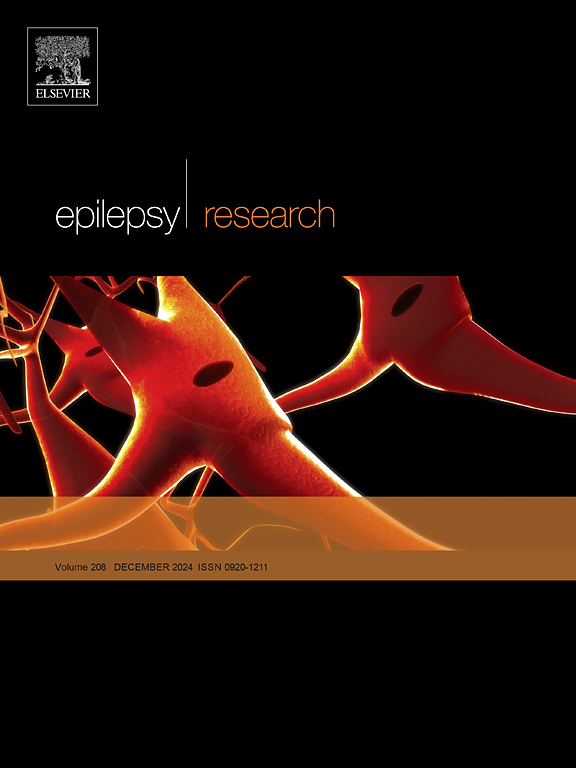SYNGAP-1发育性和癫痫性脑病:胼胝体切开术和神经调节的应用
IF 2
4区 医学
Q3 CLINICAL NEUROLOGY
引用次数: 0
摘要
SYNGAP1基因的变异导致一种罕见的儿童期发病的发育性和癫痫性脑病(DEE)。有限的报道描述了姑息性外科手术,如胼胝体切开术(CC)和迷走神经刺激(VNS)治疗syngap1相关的DEE。方法回顾性分析SynGAP研究基金公民健康数据库(Citizen)中接受CC和/或VNS治疗的去识别病历。另外还有我们中心的一个孩子。本文总结了与癫痫、合并症、遗传学、脑电图/神经影像学结果和治疗反应有关的细节。结果我们发现185名儿童可能存在致病性/致病性SYNGAP1变异;156例癫痫(n = 156/185,84.3 %)。15名儿童接受了姑息治疗(15/156,9.6 %)。11例患儿发生VNS (n = 11/15,73.3 %),中位随访时间为3.3年(IQR 5.6, 3.3)。七个孩子有一个最初的祝辞 50 %减少癫痫(63.6 n = 7/11, %),2有恶化(18.2 n = 2/11, %),1没有变化(9.1 n = 1/11, %),和1有一个未知的反应(9.1 n = 1/11, %)。3例患儿VNS反应持续(3/11,27.3 %)。2名儿童(n = 2/15,13.3 %)仅患有CC,平均随访3.1年;1例无癫痫发作,另1例癫痫发作减少>; 50% %。2例患儿(n = 2/15,13.3 %)先行VNS后行CC, 1例癫痫发作总体减少>; 50 %,1例变化最小;CC的平均随访时间为3.1年。我们中心的一名儿童在7岁时接受CC治疗后癫痫发作持续减少了>; 80 %(1.5年)。结论随着时间的推移,迷走神经刺激的效果是可变的和持续的。CC似乎在少数治疗中更有效。在syngap1相关DEE中,需要更大的队列来证实这些发现。本文章由计算机程序翻译,如有差异,请以英文原文为准。
SYNGAP-1 developmental and epileptic encephalopathy: Utility of corpus callosotomy and neuromodulation
Introduction
Variants in SYNGAP1 cause a rare childhood-onset developmental and epileptic encephalopathy (DEE). Limited reports describe palliative surgical procedures such as corpus callosotomy (CC) and vagus nerve stimulation (VNS) in SYNGAP1-related DEE.
Methods
A retrospective chart review of de-identified medical records from the SynGAP Research Fund Citizen Health Database (Citizen) who underwent CC and/or VNS was conducted. This was supplemented with one child from our centre. Details related to epilepsy, comorbidities, genetics, electroencephalogram/neuroimaging findings and treatment response are summarized.
Results
We identified 185 children with likely pathogenic/pathogenic variants in SYNGAP1; 156 had epilepsy (n = 156/185, 84.3 %). Fifteen children had palliative procedures (15/156, 9.6 %). Eleven children had VNS (n = 11/15, 73.3 %), and the median follow-up was 3.3 years (IQR 5.6, 3.3). Seven children had an initial > 50 % seizure reduction (n = 7/11, 63.6 %), 2 had worsening (n = 2/11, 18.2 %), 1 had no change (n = 1/11, 9.1 %), and 1 had an unknown response (n = 1/11, 9.1 %). VNS response was sustained in 3 children (3/11, 27.3 %). Two children (n = 2/15, 13.3 %) had CC only with a mean follow-up of 3.1 years; 1 became seizure-free, and the other had > 50 % seizure reduction. Two children (n = 2/15, 13.3 %) underwent VNS then CC, 1 had a > 50 % overall seizure reduction, and one had minimal change; mean follow up from CC was 3.1 years. One child from our centre had a sustained > 80 % seizure reduction (1.5 years) following CC at 7 years.
Conclusion
The effect of VNS was variable and sustained in less children over time. CC appeared to be more effective in the few treated. Larger cohorts are required to confirm these findings in SYNGAP1-related DEE.
求助全文
通过发布文献求助,成功后即可免费获取论文全文。
去求助
来源期刊

Epilepsy Research
医学-临床神经学
CiteScore
0.10
自引率
4.50%
发文量
143
审稿时长
62 days
期刊介绍:
Epilepsy Research provides for publication of high quality articles in both basic and clinical epilepsy research, with a special emphasis on translational research that ultimately relates to epilepsy as a human condition. The journal is intended to provide a forum for reporting the best and most rigorous epilepsy research from all disciplines ranging from biophysics and molecular biology to epidemiological and psychosocial research. As such the journal will publish original papers relevant to epilepsy from any scientific discipline and also studies of a multidisciplinary nature. Clinical and experimental research papers adopting fresh conceptual approaches to the study of epilepsy and its treatment are encouraged. The overriding criteria for publication are novelty, significant clinical or experimental relevance, and interest to a multidisciplinary audience in the broad arena of epilepsy. Review articles focused on any topic of epilepsy research will also be considered, but only if they present an exceptionally clear synthesis of current knowledge and future directions of a research area, based on a critical assessment of the available data or on hypotheses that are likely to stimulate more critical thinking and further advances in an area of epilepsy research.
 求助内容:
求助内容: 应助结果提醒方式:
应助结果提醒方式:


